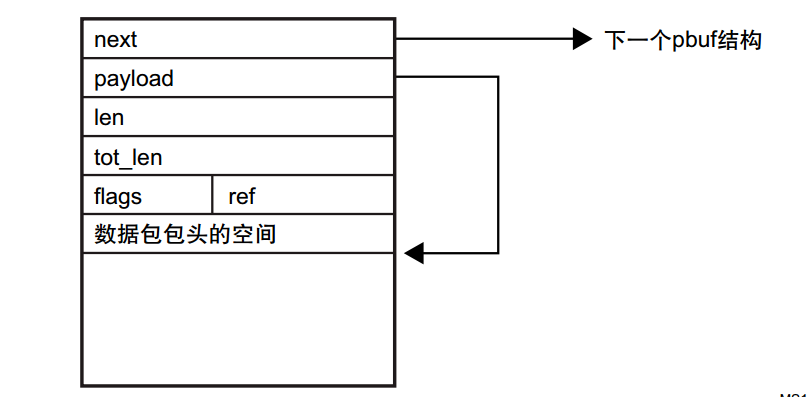一、协议中链表的应用
最近在stm32F4调试网口,移植LwIP协议上去,里边的的结构体pbuf使用了链表,如下所示:
struct pbuf {
/** next pbuf in singly linked pbuf chain */
struct pbuf *next; //指向下一个pbuf结构体,可以构成链表
/** pointer to the actual data in the buffer */
void *payload; //指向该pbuf真正的数据区
/**
* total length of this buffer and all next buffers in chain
* belonging to the same packet.
*
* For non-queue packet chains this is the invariant:
* p->tot_len == p->len + (p->next? p->next->tot_len: 0)
*/
u16_t tot_len; //当前pbuf和链表中后面所有pbuf的数据长度,它们属于一个数据包
/** length of this buffer */
u16_t len; //当前pbuf的数据长度
/** pbuf_type as u8_t instead of enum to save space */
u8_t /*pbuf_type*/ type; //当前pbuf的类型
/** misc flags */
u8_t flags; //状态为,保留
/**
* the reference count always equals the number of pointers
* that refer to this pbuf. This can be pointers from an application,
* the stack itself, or pbuf->next pointers from a chain.
*/
u16_t ref; //该pbuf被引用的次数
};
二、链表的理解
链表是一种常见的数据结构,它是动态地进行存储分配的一种结构,链表中的每一个结点的数据类型为结构体类型,结点有两部分成员组成:数据成员用于保存结点数据,地址成员则保存着指向下一个结构体类型结点的指针(即下一个结点的地址),链表的数据结构如下:
struct node
{
int num; //数据域
struct node *p; //指针域
};
所以对于上面的pbuf结构体中struct pbuf *next是指针域,指向下一个pbuf结构体,而其它定义就是数据域。

三、链表的建立和输出
根据下面的例子来看下链表是如何建立和输出:
struct HAR
{
int x,y;
struct HAR *p;
}h[2];
void main(void)
{
h[0].x=1;
h[0].y=2;
h[1].x=3;
h[1].y=4;
h[0].p=&h[1];
h[0].p=h;
printf("%d%d
",(h[0].p)->x,(h[1].p)->y);
}
结构数据h的结点关系如下所示,从中分析出(h[0].p)->x=h[1].x=3,(h[1].p)->y=h[0].y=2,所以输出的结果为32

使用链表的好处是可以构造动态的数组,根据需要随时调整数组大小,以满足不同的需要,链表是在程序执行过程中按需要申请存储空间,不会出现资源浪费。
四、参考文档
http://blog.csdn.net/lpp0900320123/article/details/20356143
by 羊羊得亿
2017-11-01 ShenZhen